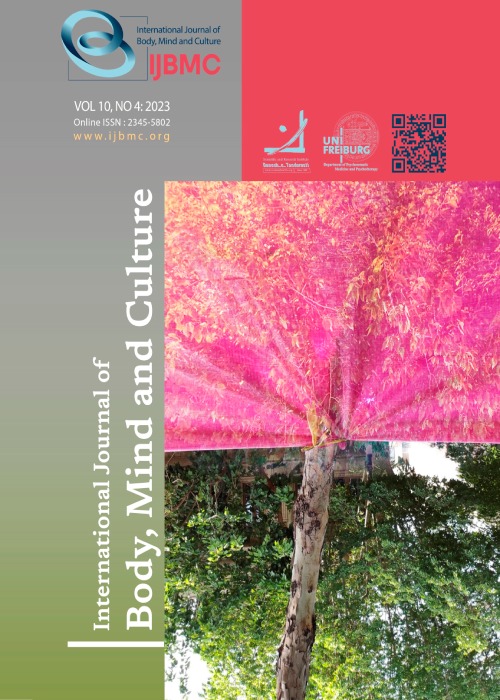فهرست مطالب

International Journal of Body, Mind and Culture
Volume:7 Issue: 4, Autumn 2020
- تاریخ انتشار: 1399/08/19
- تعداد عناوین: 8
-
Pages 184-195Background
Meeting the reproductive and sexual health needs of vulnerable adolescent girls is a priority of every community. Lack of attention to this dimension of health can be associated with issues such as unwanted pregnancy, unsafe abortion, sexually transmitted infections. Thus, the identification of these needs is a necessary step for purposive planning, operational intervention, and resource and facility allocation. The present study was conducted to explain the needs and facilitators of reproductive and sexual health in vulnerable adolescent girls.
MethodsThe present qualitative study was a part of an extensive study conducted using a mixed method to develop a reproductive and sexual program for vulnerable adolescent girls. Purposive sampling as utilized in the present study to select 16 adolescent girls of 12-19 years of age and 22 well-informed key experts. The experts participated in semi-structured interviews to provide the article with their experiences about the needs and facilitating factors of vulnerable adolescent girls’ sexual and reproductive health. The data were coded and classified following content analysis using MAXQDA software.
ResultsAfter scrutinizing and analyzing the data, the category of the needs were obtained under the title of the vulnerable adolescents’ reproductive and pregnancy health needs. The category of facilities was also obtained under the title of targeted prevention of adolescents’ vulnerability.
ConclusionRisky sexual behaviors in adolescent girls are associated with negative physical and psychological consequences for reproductive health. Family and the Welfare Organization play a significant role in supporting vulnerable adolescent girls and meeting their reproductive and sexual health needs.
-
Pages 196-202Background
Multiple sclerosis (MS) is of great importance due to its frequency, chronicity, and prevalence in young adults. The purpose of this study was to compare the body image of MS patients with that of healthy individuals.
MethodsIn the present causal-comparative study, the study population consisted of all MS patients referred to the Neurology Clinic . The study participants consisted of 200 patients (100 patients with MS and 100 healthy individuals) selected through convenience sampling. Data were obtained using the Multidimensional Body-Self Relations Questionnaire (MBSRQ) (Cash, 1990). Data were analyzed using descriptive statistics, such as mean and standard deviation, and inferential statistics, such as analysis of covariance (ANCOVA) and repeated measures analysis of variance (ANOVA), in SPSS software.
ResultsThe results of the data analysis illustrated a significant difference between MS patients and healthy people in terms of Body Areas Satisfaction Scale (BASS) and weight variables (P < 0.05).
ConclusionThis study showed that MS could have psychological consequences to help us in psychosocial treatment approaches .
-
Pages 203-213Background
AIDS is a medical and social problem, which has a high prevalence in Iran. The present study was conducted to compare the effect of mindfulness-based stress reduction and spiritual therapy techniques on increasing CD4 cells and quality of life (QOL) in AIDS patients.
MethodsThe present quasi-experimental study was performed with a pretest-posttest design and a control group. The statistical population of the study included all AIDS patients who referred to health centers in Shahriar, Iran, in 2018. From among those referred to these health centers, 45 people were selected using a convenience sampling method and were assigned to 3 groups. The patients were evaluated using the World Health Organization Quality of Life-BREF Questionnaire (WHOQOL-BREF) (WHOQOL Group, 1998) and blood tests to check CD4 cells. Then, participants in the experimental groups received mindfulness-based stress reduction and spiritual therapy during 8 sessions of 90 minutes, but the control group did not receive any training. Multivariate analysis of variance (MANOVA) was used to examine the research data.
ResultsThe results showed that spiritual therapy and mindfulness-based stress reduction techniques had a significant effect on increasing CD4 cells and QOL in AIDS patients (P < 0.001).
ConclusionIt can be concluded that mindfulness-based stress reduction had a significant effect on increasing CD4 cells and QOL in AIDS patients. Moreover, mindfulness-based stress reduction was more effective than spirituality therapy on QOL.
-
Pages 214-227Background
One of the community-based interventions for increasing mental health literacy is mental health first aid (MHFA) training. The current study measured literacy regarding MHFA for eating disorders (EDs) among the youth and adolescents.
MethodsThis cross-sectional study was performed on those aged 16-29 years in Tehran, Iran. The sample size was 252 individuals. For data gathering, the Mental Health Literacy Questionnaire (MHLQ) was used that was modified for EDs. The validity and reliability of the Persian version of the MHLQ was confirmed. Data were analyzed using SPSS software. To determine the demographic variables that can predict participants' literacy concerning EDs, logistic regression analysis was used.
ResultsAmong the participants, 11.5 could successfully diagnose EDs, 34.5 were not at all confident in their ability to help, and 36.95 said they would not seek help if faced with a similar problem. Most of the participants selected “obtaining more information about the problems described in the vignette and available services” and “listening to the problems of the vignette character in an understanding way” as the correct first aid interventions. Family and friends were mentioned as the main influential people. Higher education could significantly predict the ability to correctly diagnose the disorder (P = 0.03) and help-seeking behavior (P = 0.002). Only relatives' history of exposure to the problems described in the vignette could significantly predict higher scores in diagnosing suitable first aid (P = 0.02).
ConclusionIn general, mental health literacy regarding EDs was not suitable among the participants of this study. Thus, it seems necessary to consider targeted MHFA training, particularly in the field of EDs, to provide training in an understandable language to the community and with emphasis on seeking professional services.
-
Pages 228-237Background
Personality variables play an important and pivotal role in the multifaceted biopsychosocial model of chronic pain. The present study was performed with the aim to examine the mediating role of conscientiousness and openness to experience in the relationship of pain self-efficacy, pain management strategies, and resilience with pain perception in chronic pain patients.
MethodsThe research method used was correlational and the statistical population included all 2141 patients suffering from chronic pain referred to medical centers in Tehran, Iran, in 2018-2019. Using Cochran’s formula and convenience sampling method 410 patients were selected as the study participants. Data were obtained using the Revised NEO Personality Inventory (Costa & McCrae, 1992), Pain Self-Efficacy Questionnaire (Nicholas, 1989), Coping Strategies Questionnaire (CSQ) (Rosenstiel & Keefe, 1983), Connor-Davidson Resilience Scale (Connor & Davidson, 2003), and the West Haven-Yale Multidimensional Pain Inventory (Kerns, Turk, & Rudy, 1985). The collected data were analyzed using structural equations with partial least squares method in SPSS and Amos software.
ResultsThe findings of the present study showed that conscientiousness had no mediating role in the relationship between predictor variables of self-efficacy, pain management, and resilience and the criterion variable of pain perception, but openness to experience had a mediating role in the relationship between the above predictor and criterion variables (P < 0.001).
ConclusionIt can be concluded that conscientiousness loses its mediating role in the presence of the variable of openness to experience, and clinically, the variable of openness to experience is effective on pain management.
-
Pages 238-247Background
Taking into account the possible role of psychological factors in cardiovascular diseases (CVDs) and the fact that they interfere with the biological factors that cause CVDs, this research was designed to evaluate the efficacy of solution-focused therapy on mental health, life orientation, mental health, and meaningfulness of life in patients with CVDs.
MethodsThis was a quasi-experimental analysis with a pretest-posttest design, follow-up, and a control group. All cardiovascular patients who had referred to the Isfahan Cardiovascular Research Center, Isfahan, Iran, between January and March 2019 and had a history of heart attack or open-heart surgery in the previous month were included in the statistical population of this study. In this study, 30 patients with CVDs wishing to participate in the study were selected using convenience sampling from among patients who had the inclusion criteria and were randomly assigned to experimental and control groups (each group included 15 patients). Data were collected using Life Orientation Test (LOT), Meaning in Life Questionnaire (MLQ), and General Health Questionnaire (GHQ). The collected data were analyzed using repeated measures analysis of variance (ANOVA) and analysis of covariance (ANCOVA) in SPSS software.
ResultsThe results indicate that there was a significant difference between the solution-focused therapy and control groups in terms of the mean scores of physical symptoms (F = 95.46; P < 0.0001), anxiety (F = 70.36; P < 0.0001), social functional dysfunction (F = 54.11; P < 0.0001), depression (F = 26.70; P < 0.0001), life orientation (F = 22.36; P < 0.0001), and meaningfulness of life (F = 68.21; P < 0.0001).
ConclusionThe findings of this study have shown that solution-focused therapy is beneficial for mental health, life orientation, and meaningfulness of life in patients with CVDs and can be used in treatment centers to enhance the status of these patients.
-
Pages 248-255Background
The aim of this study was to compare the effects of cognitive-behavioral group therapy (CBGT) and existential group therapy on anxiety in addicts undergoing methadone maintenance treatment (MMT).
MethodsThe present semi-experimental research was conducted with a pretest-posttest design, follow-up, and a control group. The statistical population of the study consisted of all addicted men undergoing MMT and referring to addiction treatment and harm reduction clinics in Qazvin, Iran, in 2019 (n = 1139). A total of 36 addicted patients referring to addiction treatment and harm reduction clinics were randomly assigned to 2 experimental groups (12 in each group) and 1 control group (n = 12). After random assignment, 1 experimental group participated in 10 sessions (120 minutes for each session) of existential therapy and the other experimental group participated in 10 sessions (120 minutes for each session) of CBGT. The Beck Anxiety Inventory (BAI) was used to collect the data. Data were analyzed using mixed analysis of variance (ANOVA).
ResultsThe results showed that CBT (F = 16.84, P = 0.0001) and existential group therapy (F = 4.81, P = 0.0001) decreased anxiety levels at the level of 99% confidence interval (CI). This effect remained stable until the follow-up stage. In addition, among the two methods, CBGT was more effective on anxiety than existential group therapy (P = 0.017).
ConclusionTherapists should prioritize CBGT over other treatment modalities to reduce psychological problems such as anxiety in addicts.
-
Pages 256-266Background
Chest pain is one of the most common reasons for people to go to cardiac emergency clinics. This study was conducted with the aim to evaluate the prevalence of psychiatric disorders in patients with chest pain referred to the heart emergency clinic of Taleghani Hospital, Tehran, Iran.
MethodsThis descriptive-analytic study was performed on 103 patients with chest pain who were referred to the emergency department. Furthermore, a follow-up was carried out. Data were collected using a demographic information form and mental health survey (28-item General Health Questionnaire; Goldberg & Hillier, 1979) in the two groups of cardiac and non-cardiac chest pain.
ResultsAmong all the referred patients, 74 patients (71.8%) did not have a definitive diagnosis of cardiovascular disorders (CVDs). The results revealed that among the patients with non-cardiac chest pain, 56 (75.7%), 55 (74.3%), 54 (73%), and 22 (29.7%) individuals had phyisical disorder, anxiety, social dysfunction, and depressive disorder. Among the patients, who were definitively diagnosed with CVDs, 14 (48.3%), 10 (34.5%), 7 (24.1%), and 6 (20.7%) individuals had anxiety, physical disoreder, social dysfunction, and depressive disorder. Among all patients, physical disorder had a significant relationship with gender (P = 0.047), and physical and anxiety disorders had a significant relationship with history of recurrent chest pain in the last 6 months (P < 0.05).
ConclusionDue to the high number of non-cardiac patients who refer to the emergency department with chest pain complaints, it is recommended that all patients with chest pain complaints be screened for psychiatric diseases.


